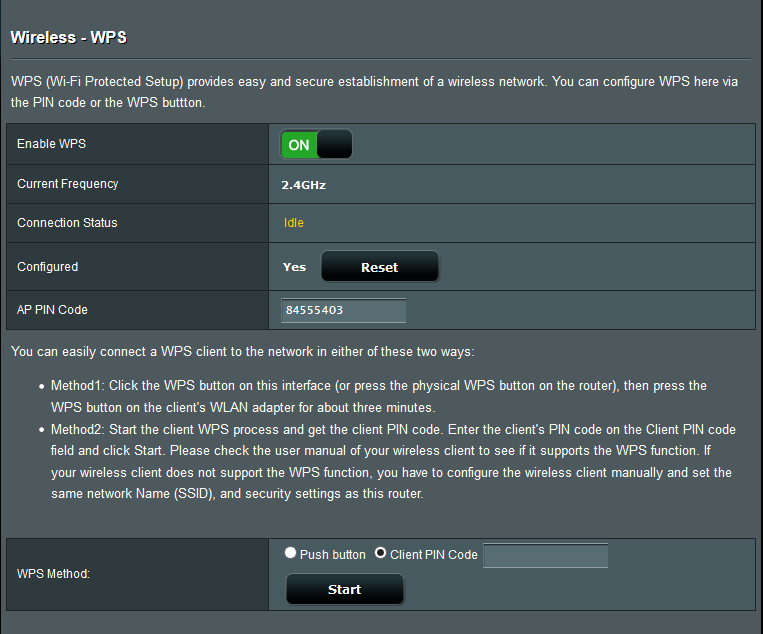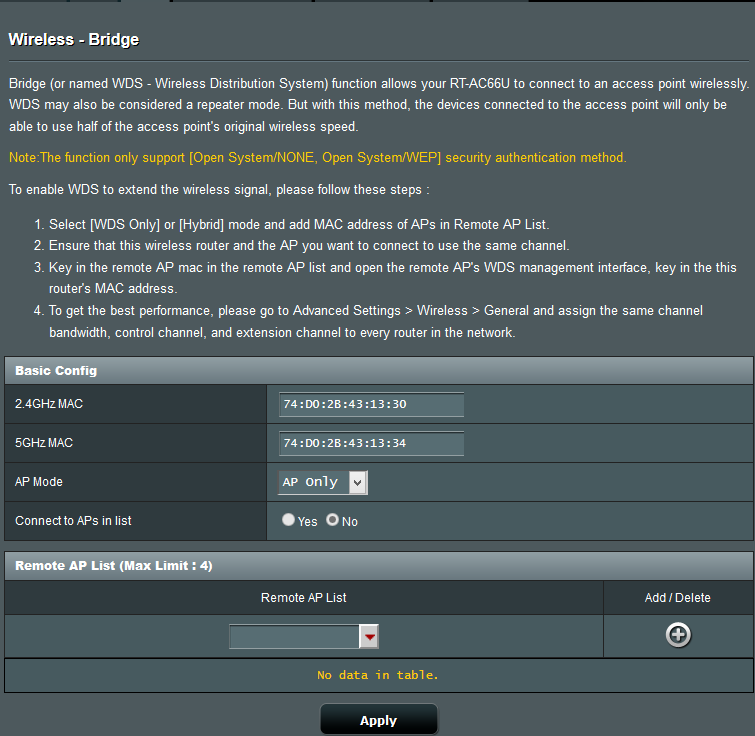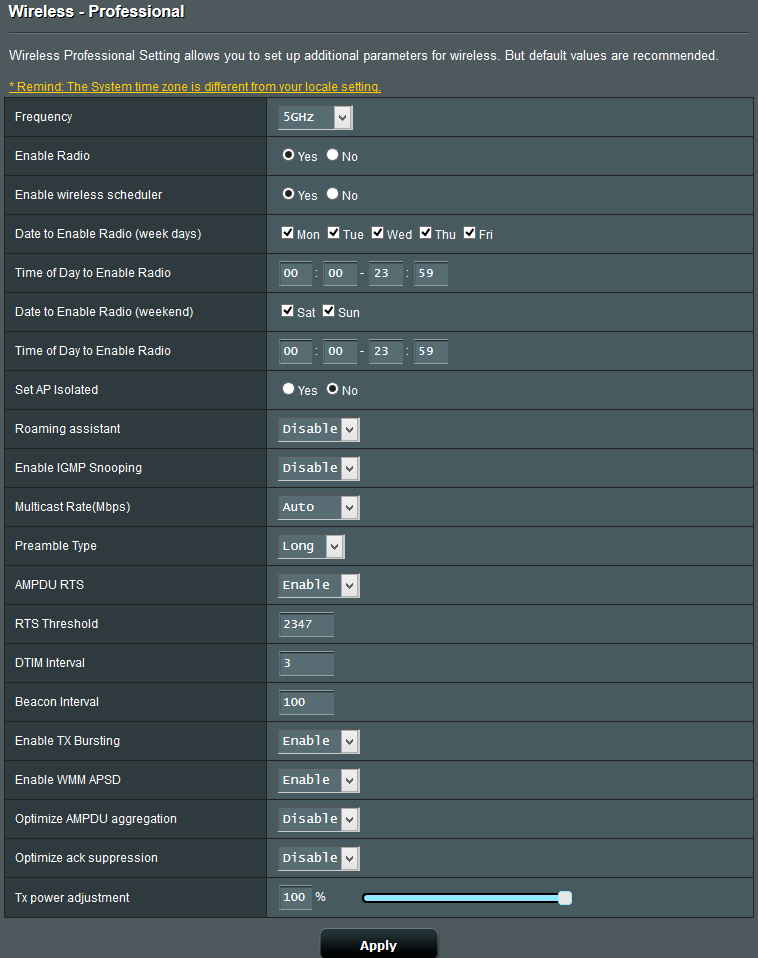TooMuchStarbucks
DD-WRT Novice
Joined: 27 Oct 2014
Posts: 20
|
 Posted: Thu Oct 30, 2014 15:19 Post subject: Posted: Thu Oct 30, 2014 15:19 Post subject: |
 |
Alright thank you.
After applying the proper settings to both devices, I actually used an online game with voice chat. When it seemed that my character wasn't moving properly and people stopped talking suddenly (like my connection dropped), I ran the command.
| Quote: | <7>[ 0.290000] pci 0000:00:00.0: [168c:0033] type 00 class 0x028000
<6>[ 0.290000] pci 0000:00:00.0: fixup device configuration
<0>[ 0.290000] bootstrap returns device 168C:33
<7>[ 0.290000] pci 0000:00:00.0: reg 10: [mem 0x00000000-0x0001ffff 64bit]
<7>[ 0.290000] pci 0000:00:00.0: reg 30: [mem 0x00000000-0x0000ffff pref]
<7>[ 0.290000] pci 0000:00:00.0: supports D1
<7>[ 0.290000] pci 0000:00:00.0: PME# supported from D0 D1 D3hot
<7>[ 0.290000] pci_bus 0000:00: busn_res: [bus 00-ff] end is updated to 00
<6>[ 0.290000] pci 0000:00:00.0: BAR 0: assigned [mem 0x10000000-0x1001ffff 64bit]
<6>[ 0.290000] pci 0000:00:00.0: BAR 6: assigned [mem 0x10020000-0x1002ffff pref]
<6>[ 0.290000] pci 0000:00:00.0: using irq 72 for pin 1
<6>[ 0.290000] Switching to clocksource MIPS
<6>[ 0.300000] NET: Registered protocol family 2
<6>[ 0.300000] TCP established hash table entries: 1024 (order: 1, 8192 bytes)
<6>[ 0.300000] TCP bind hash table entries: 1024 (order: 0, 4096 bytes)
<6>[ 0.300000] TCP: Hash tables configured (established 1024 bind 1024)
<6>[ 0.300000] TCP: reno registered
<6>[ 0.300000] UDP hash table entries: 256 (order: 0, 4096 bytes)
<6>[ 0.300000] UDP-Lite hash table entries: 256 (order: 0, 4096 bytes)
<6>[ 0.300000] NET: Registered protocol family 1
<7>[ 0.300000] PCI: CLS 0 bytes, default 32
<5>[ 0.300000] gpio_proc: module loaded and /proc/gpio/ created
<5>[ 0.300000] wl0gpio_proc: module loaded and /proc/wl0gpio/ created
<6>[ 0.300000] squashfs: version 3.0 (2006/03/15) Phillip Lougher
<6>[ 0.300000] msgmni has been set to 247
<6>[ 0.310000] io scheduler noop registered
<6>[ 0.310000] io scheduler deadline registered (default)
<6>[ 0.310000] Serial: 8250/16550 driver, 1 ports, IRQ sharing disabled
<6>[ 0.330000] serial8250.0: ttyS0 at MMIO 0x18020000 (irq = 11) is a 16550A
<6>[ 0.640000] console [ttyS0] enabled
<0>[ 0.650000] guessed flashsize = 8M
<0>[ 0.650000] scanning for root partition
<0>[ 0.660000] tplink uboot detected
<0>[ 0.660000] guessed bootloader size = 20000
<0>[ 0.670000]
<0>[ 0.670000] found squashfs at 110000
<5>[ 0.670000] Creating 9 MTD partitions on 00
<5>[ 0.680000] 0x000000000000-0x000000020000 :
<5>[ 0.680000] 0x000000020000-0x0000007e0000 :
<5>[ 0.690000] 0x000000110000-0x0000007b0000 :
<5>[ 0.700000] mtd: partition 0x0000rootfs00 :
<5>[ 0.700000] 0x0000007b0000-0x0000007e0000 :
<5>[ 0.710000] 0x0000007e0000-0x0000007f0000 :
<5>[ 0.720000] 0x0000007f0000-0x000000800000 :
<5>[ 0.720000] 0x000000000000-0x000000800000 :
<5>[ 0.730000] 0x000000000000-0x000000020000 :
<5>[ 0.740000] 0x000000010000-0x000000020000 :
<6>[ 0.740000] libphy: Fixed MDIO Bus: probed
<6>[ 0.750000] tun: Universal TUN/TAP device driver, 1.6
<6>[ 0.750000] tun: (C) 1999-2004 Max Krasnyansky
<6>[ 0.760000] PPP generic driver version 2.4.2
<6>[ 0.760000] PPP BSD Compression module registered
<6>[ 0.770000] PPP Deflate Compression module registered
<6>[ 0.770000] PPP MPPE Compression module registered
<6>[ 0.780000] NET: Registered protocol family 24
<6>[ 0.800000] u32 classifier
<6>[ 0.800000] Performance counters on
<6>[ 0.810000] input device check on
<6>[ 0.810000] Actions configured
<6>[ 0.810000] Netfilter messages via NETLINK v0.30.
<6>[ 0.820000] nf_conntrack version 0.5.0 (1976 buckets, 7904 max)
<4>[ 0.830000] nf_conntrack_rtsp v0.6.21 loading
<4>[ 0.830000] nf_nat_rtsp v0.6.21 loading
<6>[ 0.830000] ip_tables: (C) 2000-2006 Netfilter Core Team
<6>[ 0.840000] TCP: westwood registered
<6>[ 0.840000] TCP: hybla registered
<6>[ 0.850000] TCP: vegas registered
<6>[ 0.850000] NET: Registered protocol family 17
<5>[ 0.850000] Bridge firewalling registered
<6>[ 0.860000] 8021q: 802.1Q VLAN Support v1.8
<6>[ 0.860000] searching for nvram
<6>[ 0.870000] nvram size = 0
<6>[ 0.900000] Atheros AR71xx hardware watchdog driver version 0.1.0
<6>[ 0.900000] ar71xx-wdt: timeout=15 secs (max=107) ref freq=40000000
<6>[ 0.910000] VFS: Mounted root (squashfs filesystem) readonly on device 31:2.
<6>[ 0.920000] Freeing unused kernel memory: 172K (802f5000 - 80320000)
<7>[ 3.220000] ar71xx-wdt: enabling watchdog timer
<6>[ 3.390000] switch0: Atheros AR8327 rev. 4 switch registered on ag71xx-mdio.0
<6>[ 5.290000] libphy: ag71xx_mdio: probed
<6>[ 5.850000] ag71xx ag71xx.0: connected to PHY at ag71xx-mdio.0:00 [uid=004dd034, driver=Atheros AR8216/AR8236/AR8316]
<6>[ 5.860000] eth0: Atheros AG71xx at 0xb9000000, irq 4, mode:RGMII
<6>[ 7.390000] Loading modules backported from Linux version master-2014-10-08-0-g0275925
<6>[ 7.400000] Backport generated by backports.git backports-20140905-1-gde42785
<6>[ 7.540000] cfg80211: Calling CRDA to update world regulatory domain
<6>[ 7.540000] cfg80211: World regulatory domain updated:
<6>[ 7.550000] cfg80211: DFS Master region: unset
<6>[ 7.550000] cfg80211: (start_freq - end_freq @ bandwidth), (max_antenna_gain, max_eirp), (dfs_cac_time)
<6>[ 7.560000] cfg80211: (2402000 KHz - 2472000 KHz @ 40000 KHz), (N/A, 2000 mBm), (N/A)
<6>[ 7.570000] cfg80211: (2457000 KHz - 2482000 KHz @ 40000 KHz), (N/A, 2000 mBm), (N/A)
<6>[ 7.580000] cfg80211: (2474000 KHz - 2494000 KHz @ 20000 KHz), (N/A, 2000 mBm), (N/A)
<6>[ 7.590000] cfg80211: (5170000 KHz - 5250000 KHz @ 80000 KHz), (N/A, 2000 mBm), (N/A)
<6>[ 7.590000] cfg80211: (5735000 KHz - 5835000 KHz @ 80000 KHz), (N/A, 2000 mBm), (N/A)
<6>[ 7.600000] cfg80211: (57240000 KHz - 63720000 KHz @ 2160000 KHz), (N/A, 0 mBm), (N/A)
<7>[ 8.060000] ath: EEPROM regdomain: 0x0
<7>[ 8.060000] ath: EEPROM indicates default country code should be used
<7>[ 8.060000] ath: doing EEPROM country->regdmn map search
<7>[ 8.060000] ath: country maps to regdmn code: 0x3a
<7>[ 8.060000] ath: Country alpha2 being used: US
<7>[ 8.060000] ath: Regpair used: 0x3a
<7>[ 8.070000] ieee80211 phy0: Selected rate control algorithm 'minstrel_ht'
<6>[ 8.070000] ieee80211 phy0: Atheros AR9340 Rev:0 mem=0xb8100000, irq=78
<4>[ 8.080000] PCI: Enabling device 0000:00:00.0 (0000 -> 0002)
<7>[ 8.090000] ath: EEPROM regdomain: 0x0
<7>[ 8.090000] ath: EEPROM indicates default country code should be used
<7>[ 8.090000] ath: doing EEPROM country->regdmn map search
<7>[ 8.090000] ath: country maps to regdmn code: 0x3a
<7>[ 8.090000] ath: Country alpha2 being used: US
<7>[ 8.090000] ath: Regpair used: 0x3a
<7>[ 8.100000] ieee80211 phy1: Selected rate control algorithm 'minstrel_ht'
<6>[ 8.100000] ieee80211 phy1: Atheros AR9300 Rev:4 mem=0xb0000000, irq=72
<6>[ 8.110000] cfg80211: Calling CRDA for country: US
<6>[ 8.120000] cfg80211: Regulatory domain changed to country: US
<6>[ 8.120000] cfg80211: DFS Master region: FCC
<6>[ 8.130000] cfg80211: (start_freq - end_freq @ bandwidth), (max_antenna_gain, max_eirp), (dfs_cac_time)
<6>[ 8.140000] cfg80211: (2402000 KHz - 2472000 KHz @ 40000 KHz), (N/A, 3000 mBm), (N/A)
<6>[ 8.150000] cfg80211: (5170000 KHz - 5250000 KHz @ 80000 KHz), (N/A, 1700 mBm), (N/A)
<6>[ 8.150000] cfg80211: (5250000 KHz - 5330000 KHz @ 80000 KHz), (N/A, 2300 mBm), (N/A)
<6>[ 8.160000] cfg80211: (5735000 KHz - 5835000 KHz @ 80000 KHz), (N/A, 3000 mBm), (N/A)
<6>[ 8.170000] cfg80211: (57240000 KHz - 63720000 KHz @ 2160000 KHz), (N/A, 4000 mBm), (N/A)
<6>[ 8.880000] eth0: link up (1000Mbps/Full duplex)
<6>[ 9.900000] nf_conntrack: automatic helper assignment is deprecated and it will be removed soon. Use the iptables CT target to attach helpers instead.
<6>[ 10.510000] device br0 entered promiscuous mode
<6>[ 10.580000] device vlan1 entered promiscuous mode
<6>[ 10.580000] device eth0 entered promiscuous mode
<6>[ 10.630000] device vlan2 entered promiscuous mode
<6>[ 10.640000] br0: port 2(vlan2) entered forwarding state
<6>[ 10.640000] br0: port 2(vlan2) entered forwarding state
<6>[ 10.650000] br0: port 1(vlan1) entered forwarding state
<6>[ 10.660000] br0: port 1(vlan1) entered forwarding state
<6>[ 10.660000] device br0 left promiscuous mode
<6>[ 10.670000] device br0 entered promiscuous mode
<6>[ 10.720000] cfg80211: Calling CRDA to update world regulatory domain
<3>[ 10.720000] cfg80211: Invalid regulatory domain detected:
<6>[ 10.730000] cfg80211: Regulatory domain: 00
<6>[ 10.730000] cfg80211: (start_freq - end_freq @ bandwidth), (max_antenna_gain, max_eirp), (dfs_cac_time)
<6>[ 10.740000] cfg80211: (2402000 KHz - 2472000 KHz @ 40000 KHz), (N/A, 2000 mBm), (N/A)
<6>[ 10.750000] cfg80211: (2457000 KHz - 2482000 KHz @ 40000 KHz), (N/A, 2000 mBm), (N/A)
<6>[ 10.760000] cfg80211: (2474000 KHz - 2494000 KHz @ 20000 KHz), (N/A, 2000 mBm), (N/A)
<6>[ 10.770000] cfg80211: (5170000 KHz - 5250000 KHz @ 80000 KHz), (N/A, 2000 mBm), (N/A)
<6>[ 10.780000] cfg80211: (5735000 KHz - 5835000 KHz @ 80000 KHz), (N/A, 2000 mBm), (N/A)
<6>[ 10.780000] cfg80211: (57240000 KHz - 63720000 KHz @ 2160000 KHz), (N/A, 0 mBm), (N/A)
<6>[ 10.820000] cfg80211: Calling CRDA to update world regulatory domain
<6>[ 10.830000] cfg80211: World regulatory domain updated:
<6>[ 10.840000] cfg80211: DFS Master region: unset
<6>[ 10.840000] cfg80211: (start_freq - end_freq @ bandwidth), (max_antenna_gain, max_eirp), (dfs_cac_time)
<6>[ 10.850000] cfg80211: (2402000 KHz - 2472000 KHz @ 40000 KHz), (N/A, 2000 mBm), (N/A)
<6>[ 10.860000] cfg80211: (2457000 KHz - 2482000 KHz @ 40000 KHz), (N/A, 2000 mBm), (N/A)
<6>[ 10.870000] cfg80211: (2474000 KHz - 2494000 KHz @ 20000 KHz), (N/A, 2000 mBm), (N/A)
<6>[ 10.870000] cfg80211: (5170000 KHz - 5250000 KHz @ 80000 KHz), (N/A, 2000 mBm), (N/A)
<6>[ 10.880000] cfg80211: (5735000 KHz - 5835000 KHz @ 80000 KHz), (N/A, 2000 mBm), (N/A)
<6>[ 10.890000] cfg80211: (57240000 KHz - 63720000 KHz @ 2160000 KHz), (N/A, 0 mBm), (N/A)
<6>[ 10.920000] cfg80211: Calling CRDA for country: US
<6>[ 10.920000] cfg80211: Regulatory domain changed to country: US
<6>[ 10.930000] cfg80211: DFS Master region: FCC
<6>[ 10.930000] cfg80211: (start_freq - end_freq @ bandwidth), (max_antenna_gain, max_eirp), (dfs_cac_time)
<6>[ 10.940000] cfg80211: (2402000 KHz - 2472000 KHz @ 40000 KHz), (N/A, 3000 mBm), (N/A)
<6>[ 10.950000] cfg80211: (5170000 KHz - 5250000 KHz @ 80000 KHz), (N/A, 1700 mBm), (N/A)
<6>[ 10.960000] cfg80211: (5250000 KHz - 5330000 KHz @ 80000 KHz), (N/A, 2300 mBm), (N/A)
<6>[ 10.970000] cfg80211: (5735000 KHz - 5835000 KHz @ 80000 KHz), (N/A, 3000 mBm), (N/A)
<6>[ 10.970000] cfg80211: (57240000 KHz - 63720000 KHz @ 2160000 KHz), (N/A, 4000 mBm), (N/A)
<6>[ 11.810000] device br0 left promiscuous mode
<6>[ 13.250000] ath1: authenticate with 74:d0:2b:43:13:34
<6>[ 13.260000] ath1: send auth to 74:d0:2b:43:13:34 (try 1/3)
<6>[ 13.270000] ath1: authenticated
<6>[ 13.310000] ath1: associate with 74:d0:2b:43:13:34 (try 1/3)
<6>[ 13.310000] ath1: RX AssocResp from 74:d0:2b:43:13:34 (capab=0x11 status=0 aid=5)
<6>[ 13.320000] ath1: associated
<6>[ 25.680000] br0: port 2(vlan2) entered forwarding state
<6>[ 25.680000] br0: port 1(vlan1) entered forwarding state
<6>[ 151.610000] br0: port 2(vlan2) entered disabled state
<6>[ 151.620000] br0: port 1(vlan1) entered disabled state
<6>[ 151.640000] device vlan1 left promiscuous mode
<6>[ 151.650000] br0: port 1(vlan1) entered disabled state
<6>[ 151.660000] device vlan2 left promiscuous mode
<6>[ 151.660000] device eth0 left promiscuous mode
<6>[ 151.660000] br0: port 2(vlan2) entered disabled state
<6>[ 151.760000] ath1: deauthenticating from 74:d0:2b:43:13:34 by local choice (Reason: 3=DEAUTH_LEAVING)
<6>[ 151.950000] device br0 entered promiscuous mode
<6>[ 152.060000] device vlan1 entered promiscuous mode
<6>[ 152.060000] device eth0 entered promiscuous mode
<6>[ 152.110000] device vlan2 entered promiscuous mode
<6>[ 152.120000] br0: port 2(vlan2) entered forwarding state
<6>[ 152.130000] br0: port 2(vlan2) entered forwarding state
<6>[ 152.130000] br0: port 1(vlan1) entered forwarding state
<6>[ 152.140000] br0: port 1(vlan1) entered forwarding state
<6>[ 152.140000] device br0 left promiscuous mode
<6>[ 152.150000] device br0 entered promiscuous mode
<6>[ 152.200000] cfg80211: Calling CRDA to update world regulatory domain
<3>[ 152.230000] cfg80211: Invalid regulatory domain detected:
<6>[ 152.230000] cfg80211: Regulatory domain: 00
<6>[ 152.230000] cfg80211: (start_freq - end_freq @ bandwidth), (max_antenna_gain, max_eirp), (dfs_cac_time)
<6>[ 152.240000] cfg80211: (2402000 KHz - 2472000 KHz @ 40000 KHz), (N/A, 2000 mBm), (N/A)
<6>[ 152.250000] cfg80211: (2457000 KHz - 2482000 KHz @ 40000 KHz), (N/A, 2000 mBm), (N/A)
<6>[ 152.260000] cfg80211: (2474000 KHz - 2494000 KHz @ 20000 KHz), (N/A, 2000 mBm), (N/A)
<6>[ 152.270000] cfg80211: (5170000 KHz - 5250000 KHz @ 80000 KHz), (N/A, 2000 mBm), (N/A)
<6>[ 152.280000] cfg80211: (5735000 KHz - 5835000 KHz @ 80000 KHz), (N/A, 2000 mBm), (N/A)
<6>[ 152.290000] cfg80211: (57240000 KHz - 63720000 KHz @ 2160000 KHz), (N/A, 0 mBm), (N/A)
<6>[ 152.350000] cfg80211: Calling CRDA to update world regulatory domain
<6>[ 152.360000] cfg80211: World regulatory domain updated:
<6>[ 152.360000] cfg80211: DFS Master region: unset
<6>[ 152.370000] cfg80211: (start_freq - end_freq @ bandwidth), (max_antenna_gain, max_eirp), (dfs_cac_time)
<6>[ 152.380000] cfg80211: (2402000 KHz - 2472000 KHz @ 40000 KHz), (N/A, 2000 mBm), (N/A)
<6>[ 152.380000] cfg80211: (2457000 KHz - 2482000 KHz @ 40000 KHz), (N/A, 2000 mBm), (N/A)
<6>[ 152.390000] cfg80211: (2474000 KHz - 2494000 KHz @ 20000 KHz), (N/A, 2000 mBm), (N/A)
<6>[ 152.400000] cfg80211: (5170000 KHz - 5250000 KHz @ 80000 KHz), (N/A, 2000 mBm), (N/A)
<6>[ 152.410000] cfg80211: (5735000 KHz - 5835000 KHz @ 80000 KHz), (N/A, 2000 mBm), (N/A)
<6>[ 152.420000] cfg80211: (57240000 KHz - 63720000 KHz @ 2160000 KHz), (N/A, 0 mBm), (N/A)
<6>[ 152.510000] cfg80211: Calling CRDA for country: US
<6>[ 152.520000] cfg80211: Regulatory domain changed to country: US
<6>[ 152.520000] cfg80211: DFS Master region: FCC
<6>[ 152.530000] cfg80211: (start_freq - end_freq @ bandwidth), (max_antenna_gain, max_eirp), (dfs_cac_time)
<6>[ 152.540000] cfg80211: (2402000 KHz - 2472000 KHz @ 40000 KHz), (N/A, 3000 mBm), (N/A)
<6>[ 152.550000] cfg80211: (5170000 KHz - 5250000 KHz @ 80000 KHz), (N/A, 1700 mBm), (N/A)
<6>[ 152.550000] cfg80211: (5250000 KHz - 5330000 KHz @ 80000 KHz), (N/A, 2300 mBm), (N/A)
<6>[ 152.560000] cfg80211: (5735000 KHz - 5835000 KHz @ 80000 KHz), (N/A, 3000 mBm), (N/A)
<6>[ 152.570000] cfg80211: (57240000 KHz - 63720000 KHz @ 2160000 KHz), (N/A, 4000 mBm), (N/A)
<6>[ 153.140000] device br0 left promiscuous mode
<6>[ 154.640000] ath1: authenticate with 74:d0:2b:43:13:34
<6>[ 154.650000] ath1: send auth to 74:d0:2b:43:13:34 (try 1/3)
<6>[ 154.660000] ath1: authenticated
<6>[ 154.680000] ath1: associate with 74:d0:2b:43:13:34 (try 1/3)
<6>[ 154.680000] ath1: RX AssocResp from 74:d0:2b:43:13:34 (capab=0x11 status=0 aid=5)
<6>[ 154.690000] ath1: associated
<6>[ 167.160000] br0: port 2(vlan2) entered forwarding state
<6>[ 167.160000] br0: port 1(vlan1) entered forwarding state |
I also have to bring up that one of the links you provide, the "Qualcomm Atheros Client/Repeater Bridge Wiki" one, actually recommends setting Default GW Mode mode to Auto. However I can't seem to access the internet whatsoever unless I set it to manual and put it a manual IP (the same as the Asus router). Also is using a Virtual Interface needed, seeing as it's another step on that wiki as well? |
|























